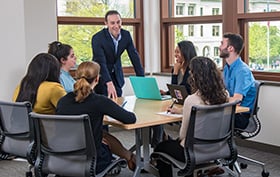How Top Schools Invest In Student Success
THIS GUIDE IS NO LONGER ACTIVE. For the current FP Guide, click here.
American University, School of International Service
Investing to Create a Continuum Between Scholars and Practitioners

At American University’s School of International Service (SIS), the process of investing in student success is what Dean and Professor Shannon Hader describes as “creating a continuum between scholars and practitioners.”
Creating a continuum between scholarship and real-world practice starts with SIS’s innovative frame of understanding the world, Hader says.
“The frame we embody, invest in, and teach from is a unique frame of the world,” says Hader. “We like to say that we do global differently. Our departments are organized to go beyond multidisciplinary so that students are valuable, nontraditional thinkers in whatever career they pursue.”
In practice, this might look like a student interested in climate policy also being exposed to courses and field experiences in anti-poverty and health. “If you want to be cutting-edge and offer big, innovative ideas, you need to understand the intersection of issues,” Hader says. “We want to empower students to leave with more than just the basics.”

“Our average class size is 16, which means your professors and classmates know you and really care about your success. They’re your future colleagues.” –Shannon Hader, Dean and Professor, School of International Service, American University
With almost all SIS graduate courses being held in the evening, students can gain practical field experience during the day in government, nongovernmental organizations, corporate, and other settings in Washington, DC, while designing a course schedule that is tailored to their unique goals.
The curriculum offers plentiful ways for students to gain practical experience. Hader points to opportunities for SIS students to receive credit for practica in which the US Department of State, think tanks, private sector consultancies, and other organizations request a consultancy project. “Students learn to work as a team, crafting consultancy-level solutions with the presentations, pitching, and responsiveness that clients expect in the workplace,” Hader says.
SIS has invested in recent years to ensure that its blend of scholarship and real-world practice is accessible to graduate students from different backgrounds. That includes a partnership with the Pat Tillman Foundation, meaning that any SIS student selected as a Tillman Scholar receives a $5,000 funding match. Twenty percent of SIS students are first-generation college students, an accomplishment that Hader says has been made possible by an alumni fund that also provides direct emergency aid, such as when a student recently lost her home and belongings in a fire.
Throughout and beyond their time at SIS, Hader says students have access to robust career services, resulting in 91 percent of students being employed or in another degree program within six months of graduation.
Bridging Classroom to Career with Practicum and Skills Institutes
SIS degrees are intentionally designed to give students the tools they need to deal with real-life situations. These include the practicum, a consulting project that works with real-world clients, and the skills institutes, which are crash courses taught by practitioners from the field. Sample practica include Alternative Strategies: Maintaining NATO’s Competitive Advantage; Conflict and Climate Migration; Intelligence and Analysis; and Peace and Security in the Middle East and Africa. Sample skills institutes include Briefing Policymakers; Building Cross-Sector Partnerships; Cultural Diplomacy and Protocols; and Data Visualization.
American University, School of International Service
https://www.american.edu/sis
[email protected]
202-885-1646![]()
Contents
- How Top Schools Invest In Student Success
- George Washington University, Elliott School of International Affairs
- Rice University, School of Social Sciences
- Princeton University, Princeton School of Public and International Affairs
- Augusta University, Pamplin College of Arts, Humanities, and Social Sciences
- The Fletcher School at Tufts University
- Indiana University, Hamilton Lugar School of Global and International Studies
- Columbia University, School of International and Public Affairs
- Penn State University, School of International Affairs
- Texas A&M University, Bush School of Government & Public Service
- Georgetown University, School of Foreign Service
- University of Denver, Josef Korbel School of International Studies
- Yale University, Jackson School of Global Affairs
- George Mason University, Schar School of Policy and Government
- American University, School of International Service
- Seton Hall University, School of Diplomacy and International Relations
- Johns Hopkins University School of Advanced International Studies
